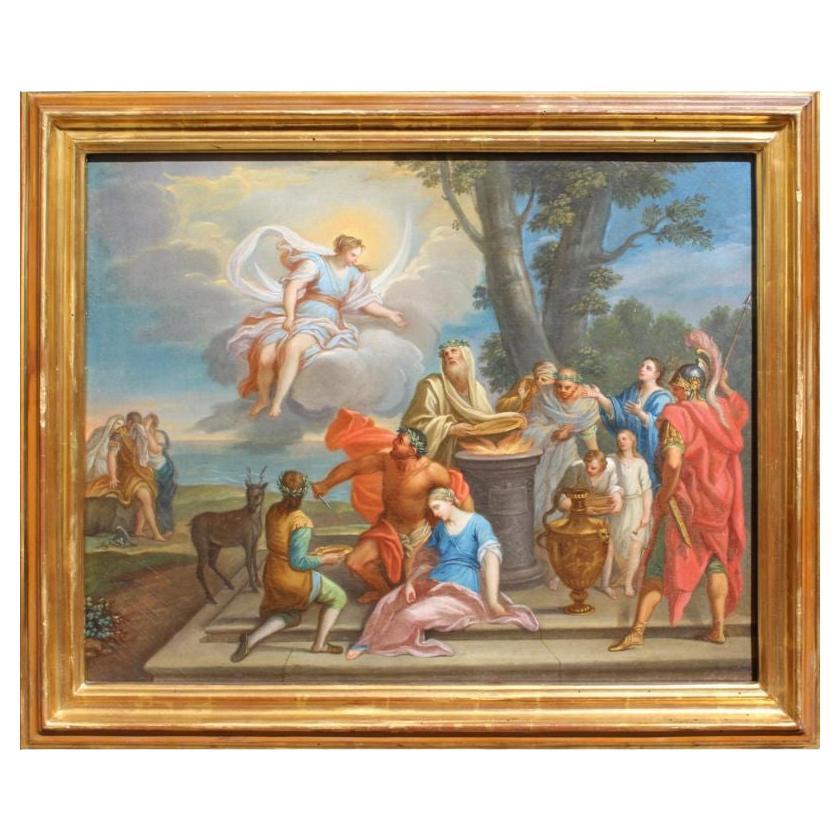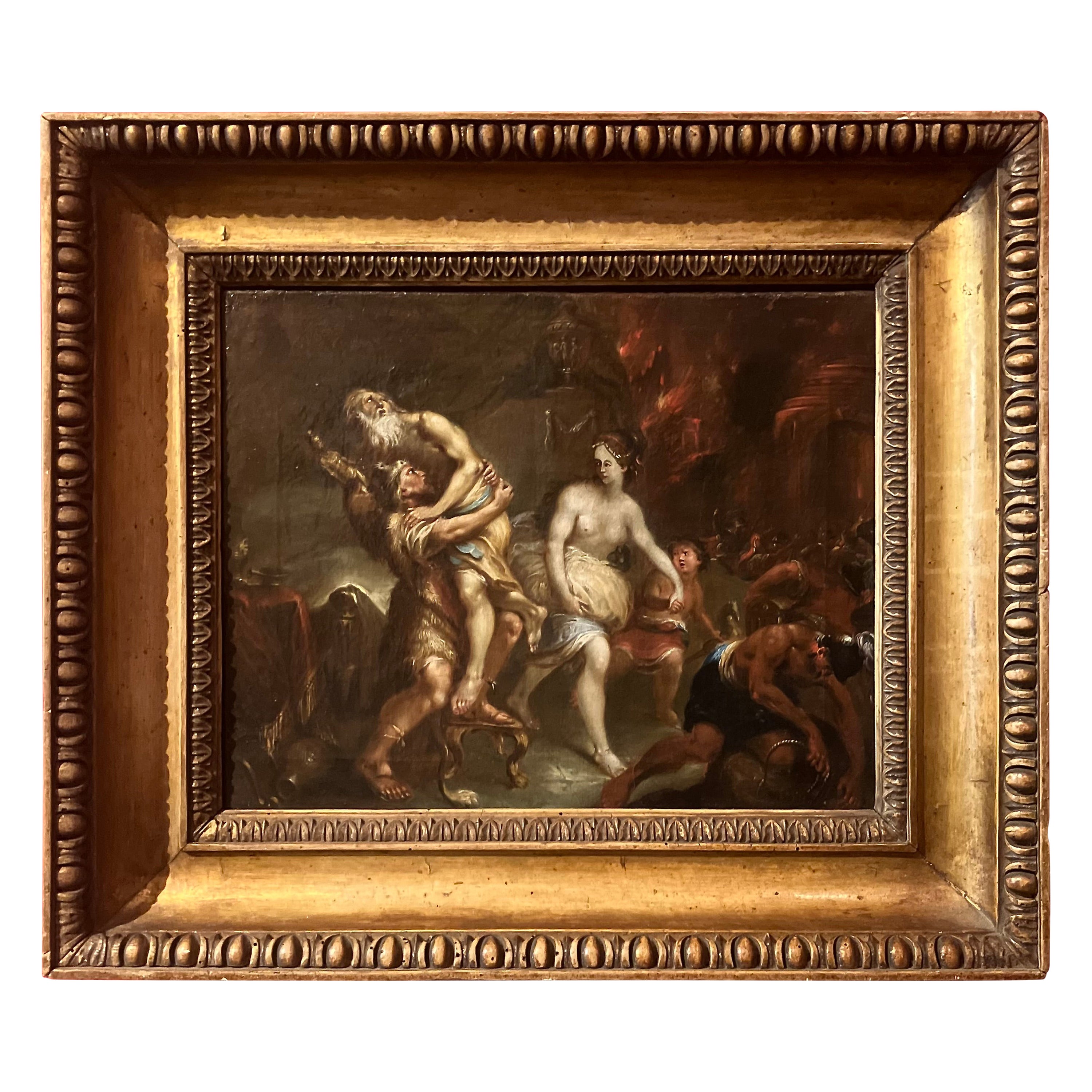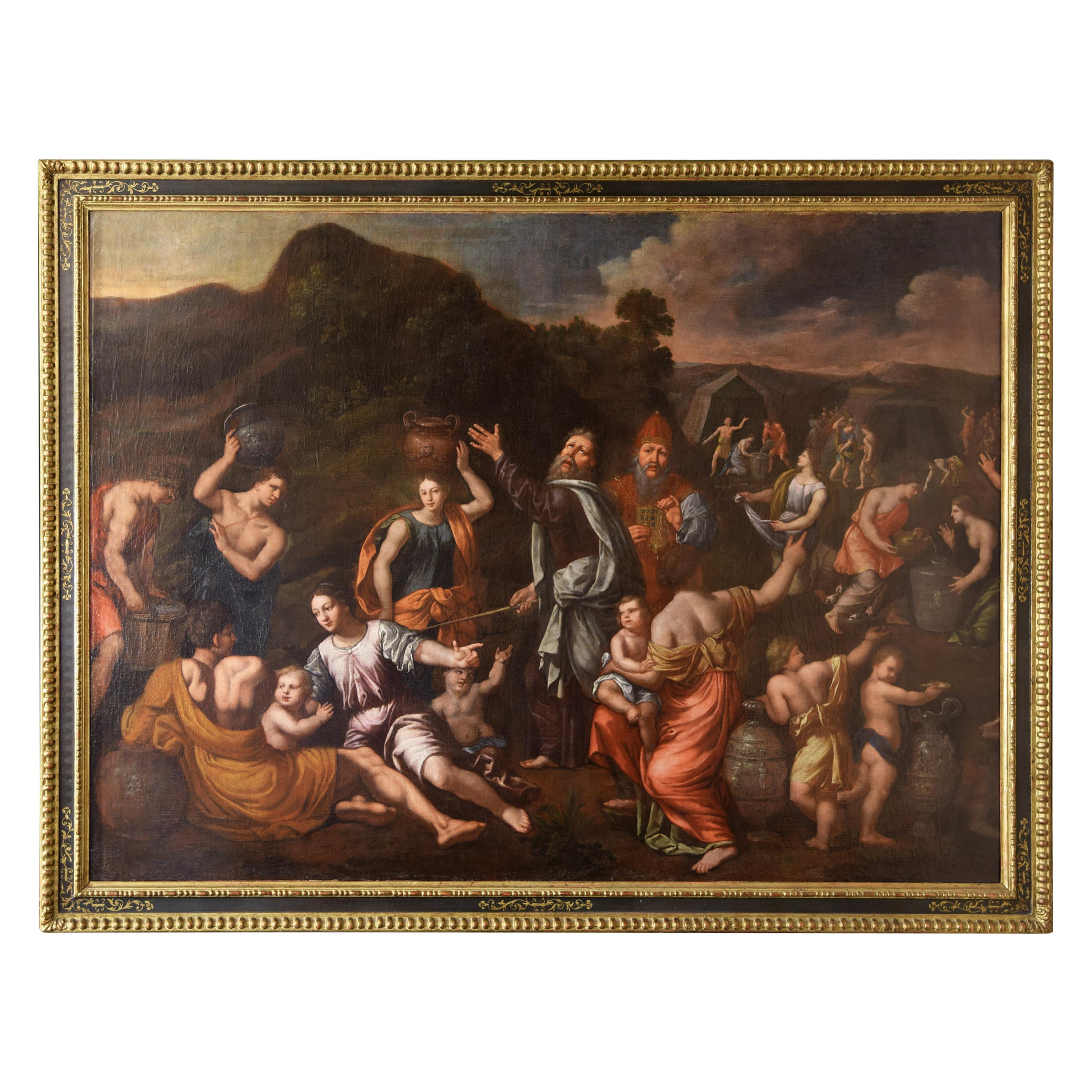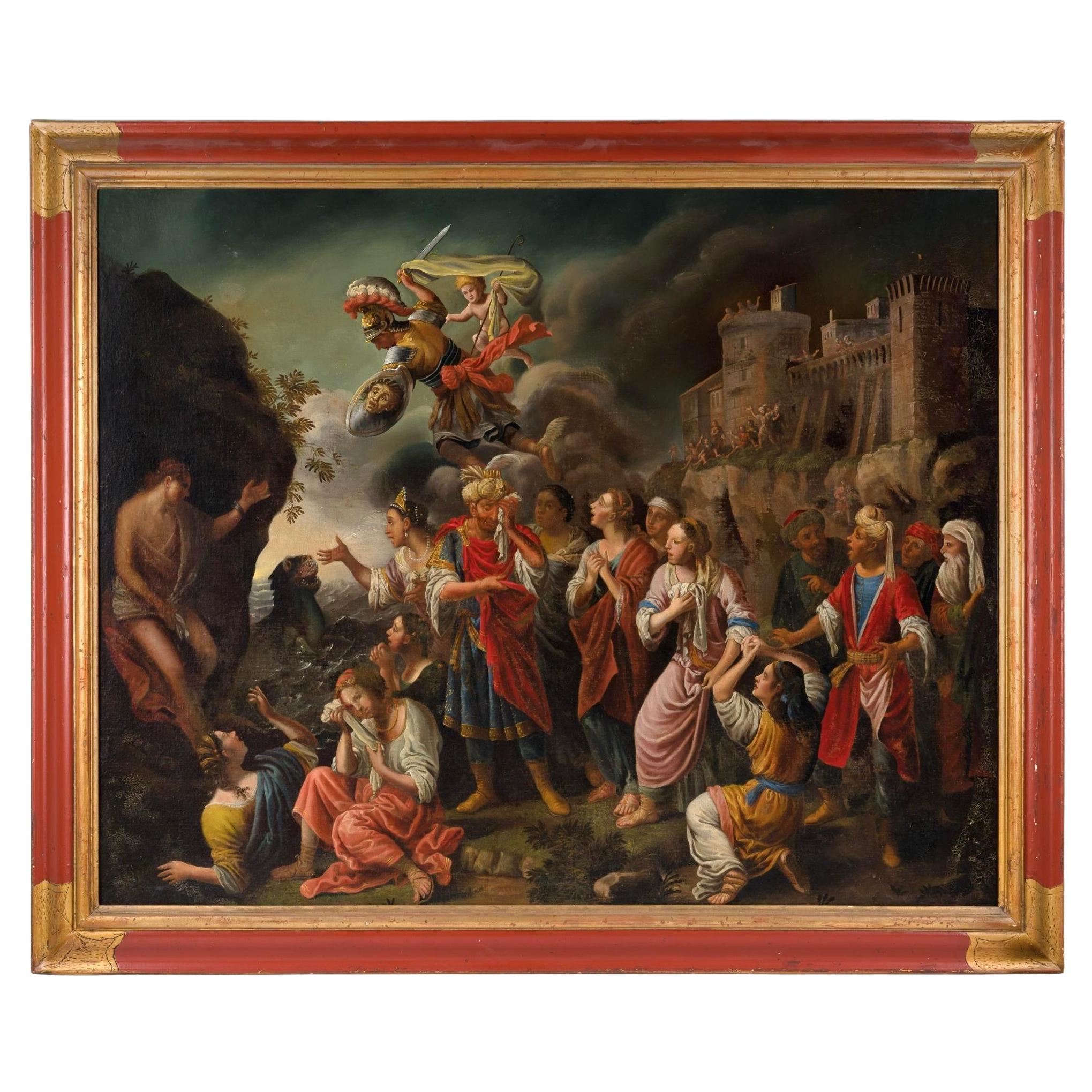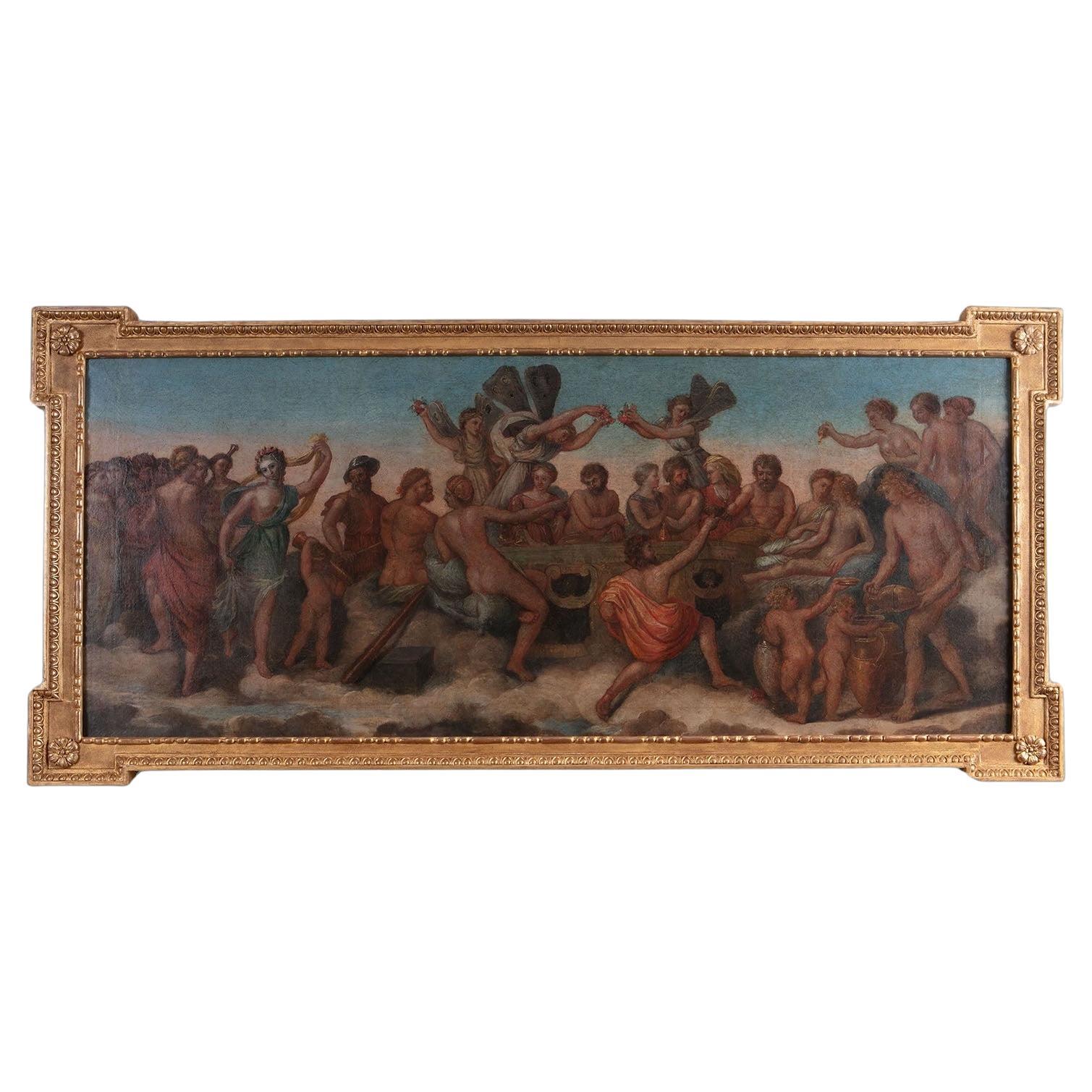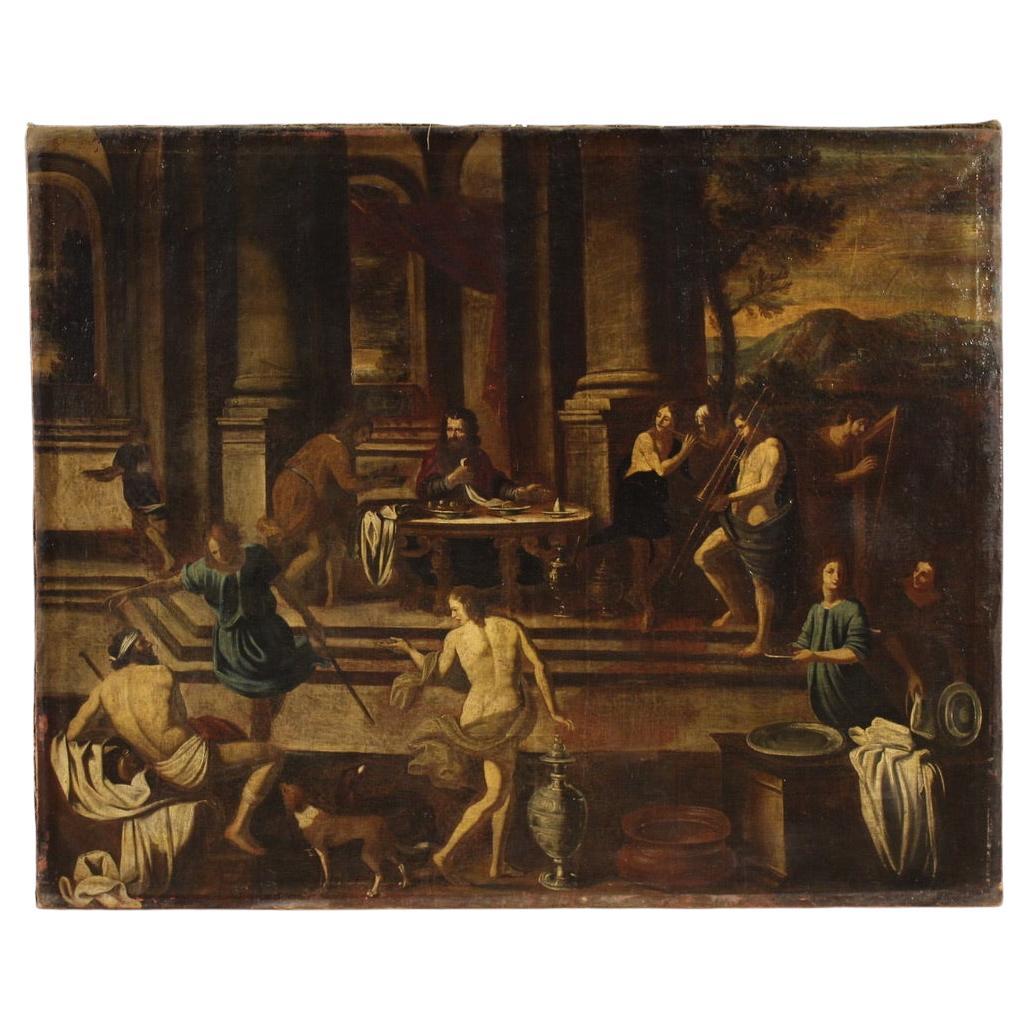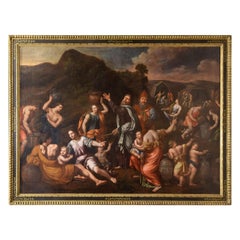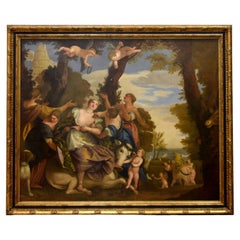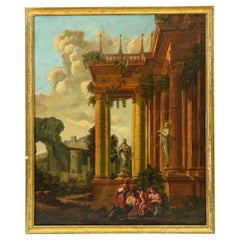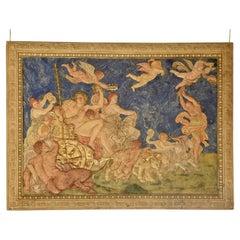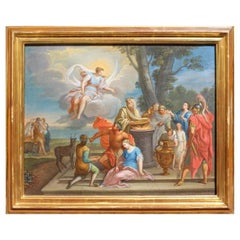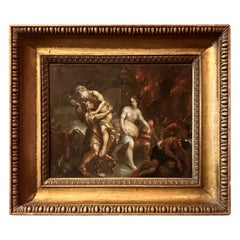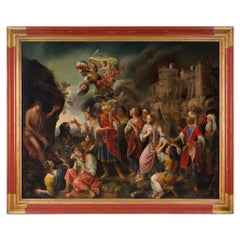Items Similar to "Wedding of Tethys and Peleus", Oil on Canvas, School of Madrid, Spain
Want more images or videos?
Request additional images or videos from the seller
1 of 9
"Wedding of Tethys and Peleus", Oil on Canvas, School of Madrid, Spain
$8,860.89
£6,641.79
€7,500
CA$12,173.36
A$13,590.41
CHF 7,121.17
MX$166,360.01
NOK 90,438.97
SEK 85,272.46
DKK 57,092.74
Shipping
Retrieving quote...The 1stDibs Promise:
Authenticity Guarantee,
Money-Back Guarantee,
24-Hour Cancellation
About the Item
"Wedding of Tethys and Peleus". Oil on canvas. School of Madrid, 17th century. Corte, Juan de la (Antwerp, circa 1585 - Madrid, 1662) circle.
This work describes the weddings of the Nereid Thetis and the prince Peleo, parents of Achilles. It was celebrated on Mount Pelion, and all the deities came, although Eris, the goddess of discord, was not invited. In revenge, she threw a golden apple in which she said "for the most beautiful", that caused the dispute between Athena, Aphrodite and Hera that led to the Trial of Paris, to finally bring about the Trojan War. The banquet is depicted with a composition worked in depth, located in a rich interior of classical architecture illuminated by the light of Apollo, which is situated at the far end of the viewer. At the head of the table, in the foreground, appears Zeus, accompanied by the eagle and Hera, queen of the gods, to his left. In the lower right corner we see a group of satyrs serving the wine, accompanied by rich metal vessels worked with a detailed and descriptive brushstroke. The rest of the gods appear clearly differentiated, with Athena in the foreground to the right and, following an agile rhythm in zigzag, typically baroque, Aphrodite with Eros, Hermes and the grooms, to the left, and to the right Poseidon. Formally it is a work perfectly framed within the 17th century school of Madrid, developed around the court.
Thus, we see a sumptuous, allegorical classicist baroque, where the studies of light and color are especially relevant, revealing the exalted and luminous tone typical of this school's maturity. In particular, we can relate this painting to the circle of Juan de la Corte, painter of Flemish origin. We know nothing of his first formation today, for Palomino's assertion of his birth in Spain was documented, quoting in his testament that he was born in Antwerp. Also conserved documents in which the painter declares his apprenticeship in Flanders, where "it exerted his office by many years". For all this he has been associated with Flemish artists of the time who, due to personal knowledge or the study of his works, strongly influenced the configuration of his personal language. We know of his establishment in Spain at least since 1613. His work at the court encouraged him to ask for the place of royal painter who left vacant Bartolomé González in 1627, a goal he did not get. There is no documentary proof, therefore, that endorses the affirmation of Palomino when citing him like painter of the king. Nevertheless, it enjoyed a moderate success in the capital of the kingdom, being found his works in numerous noble inventories of the time. In turn, he enjoyed royal commissions, such as the cycle of biblical stories he painted for the Buen Retiro palace. His activity, according to his own confession, focused on "architectures, battles and countries", genres in which he was excellently valued by his contemporaries. One of the most interesting features of his style is the fact that he has often dealt with mythological subjects which, taken to the canvas in different cycles, offer us a singularly majestic panorama of a theme not frequent in the painting of Spain of the time. Another outstanding aspect of his work was the proliferation of architectural perspectives of evident linkage with the Nordic writers, most notably Vredeman de Vries. His pictorial style remained anchored in earlier traditions, demonstrating an obvious modesty and archaism, but the uniqueness of the issues he dealt made him worthy of the memory. Juan de la Corte is represented in the Museo del Prado, the Maritime of Barcelona, the Cerralbo and the Municipal of Madrid, among others .
· Size: 97 x 122 cm; 116 x 143 cm (marco). 7 cm (Depth).
- Similar to:Juan de la Corte (Artist)
- Dimensions:Height: 45.67 in (116 cm)Width: 56.3 in (143 cm)Depth: 2.76 in (7 cm)
- Style:Baroque (Of the Period)
- Materials and Techniques:
- Place of Origin:
- Period:
- Date of Manufacture:17th Century
- Condition:Wear consistent with age and use. Minor losses. Minor fading.
- Seller Location:Madrid, ES
- Reference Number:Seller: Z62971stDibs: LU2951312951351
About the Seller
4.9
Vetted Professional Seller
Every seller passes strict standards for authenticity and reliability
Established in 1985
1stDibs seller since 2017
346 sales on 1stDibs
Typical response time: 8 hours
- ShippingRetrieving quote...Shipping from: Madrid, Spain
- Return Policy
Authenticity Guarantee
In the unlikely event there’s an issue with an item’s authenticity, contact us within 1 year for a full refund. DetailsMoney-Back Guarantee
If your item is not as described, is damaged in transit, or does not arrive, contact us within 7 days for a full refund. Details24-Hour Cancellation
You have a 24-hour grace period in which to reconsider your purchase, with no questions asked.Vetted Professional Sellers
Our world-class sellers must adhere to strict standards for service and quality, maintaining the integrity of our listings.Price-Match Guarantee
If you find that a seller listed the same item for a lower price elsewhere, we’ll match it.Trusted Global Delivery
Our best-in-class carrier network provides specialized shipping options worldwide, including custom delivery.More From This Seller
View AllGathering of Manna, Oil on Canvas, 17th Century
Located in Madrid, ES
Jews in the desert collecting the Manna. Oil on canvas, XVII century.
Oil on canvas arranged horizontally in which a figurative theme is shown with a mountainous landscape in the ba...
Category
Antique 17th Century Spanish Baroque Paintings
Materials
Other
Abduction of Europe Oil on Canvas, 18th Century, After Veronese
By Paolo Veronese
Located in Madrid, ES
Rapture of Europe Oil on canvas. 17th century, following the model of VERONESE, Paolo Caliari (Verona, 1528-Venice, 1588).
Oil on canvas showing a scen...
Category
Antique 18th Century European Baroque Paintings
Materials
Other
Landscape with Classical Ruins, Oil on Canvas, Attributed to Giner, Vicente
Located in Madrid, ES
Landscape with classical ruins. Oil on canvas. Attributed to Giner, Vicente (ca. 1636-1681).
Reengineered (reentelado in spanish).
Landscape with rocks and buildings in the background that presents, in the foreground, constructions with a marked classicist air, accompanied by two female sculptures on two pedestals. At the foot of this building, there is a group of people, dressed in the classic way (women, children and a soldier with a spear). Vicente Giner, canon and artist from Castellón, is documented working in Rome during the last quarter of the seventeenth century (until he died here in 1681), where he requested, together with others, from Carlos II...
Category
Antique 17th Century European Baroque Paintings
Materials
Other
"Triumph of Bacchus and Ariadne". 20th century, after Annibale Carracci
Located in Madrid, ES
"Triumph of Bacchus and Ariadne" after Annibale Carracci's model. Modeled alabaster
The classical deities Bacchus and Ariadne have been represented in a chariot, accompanied by a pr...
Category
20th Century European Other Decorative Art
Materials
Resin
Last Supper. Oil on panel. Castilian School, 16th century.
Located in Madrid, ES
Last Supper. Oil on panel. Castilian School, 16th century.
It has faults.
An oil on panel painting depicting a figurative image against a neutral background, with a checkered tile...
Category
Antique 16th Century Spanish Renaissance Religious Items
Materials
Other
"Triumph of Bacchus and Ariadne". 20th century, after Annibale Carracci
By Annibale Carracci
Located in Madrid, ES
"Triumph of Bacchus and Ariadne" after Annibale Carracci's model. Polychrome resin.
The classical deities Bacchus and Ariadne have been represente...
Category
20th Century European Other Decorative Art
Materials
Resin
You May Also Like
18th Century The Sacrifice of Iphigenia Roma School Painting Oil on Canvas
Located in Milan, IT
Roman school, 18th century
The Sacrifice of Iphigenia
Oil on canvas, Measures: 50 x 64.5 cm
The canvas depicts The Sacrifice of Iphigenia, a theme reported by numerous sources, including the Greek tragedies Iphigenia in Aulis by Euripides and Agamemnon by Aeschylus, as well as in Ovid's Metamorphoses. The myth tells how the Greeks, under the command of Agamemnon, gathered at the city of Aulis, in Boeotia, from which they then set sail for Troy. The persistent calm of the winds, however, prevents the Greek ships...
Category
Antique 18th Century Italian Paintings
Materials
Canvas
Aeneas Fleeing the Burning of Troy, 17th Century Flemish Oil on Canvas Painting
Located in Firenze, IT
This oil painting on canvas, created by an artist from the 17th Century Flemish School, depicts one of the most significant scenes from Greco-Roman mythology: Aeneas saving his famil...
Category
Antique 17th Century Dutch Baroque Paintings
Materials
Giltwood, Paint
"Perseus Rescuing Andromeda" Oil on Canvas Large Old Master Painting
Located in Bradenton, FL
"Perseus Rescuing Andromeda" Masterful Old Master Oil on Canvas Painting, Large size, framed. Painting depicts the dramatic scene from Greek mythology where Perseus, the hero, saves ...
Category
Antique 18th Century Italian Renaissance Paintings
Materials
Canvas, Paint
MARRIAGE OF CUPID AND PSYCHE OIL ON CANVAS in Giltwood Kent Style Frame
Located in Reepham, GB
This oil on canvas is a meticulous reproduction of Giovanni Francesco Penni’s “Marriage of Cupid and Psyche” fresco (1517-18) from Villa Farnesina, Rome. Framed in an intricately car...
Category
Antique Early 19th Century Decorative Art
Materials
Paint
17th century Oil on Canvas Italian Biblical Painting Herod's Banquet, 1650
Located in Vicoforte, Piedmont
Antique Italian painting from the mid-17th century. Oil on canvas artwork, first canvas, depicting a biblical episode of great charm, Herod's banquet, of excellent pictorial quality....
Category
Antique 1650s Italian Paintings
Materials
Canvas
18th-19th Century Oil on Canvas "The Triumph of Venice" After Paolo Veronese
By Paolo Veronese
Located in Los Angeles, CA
A very fine and Large Italian 18th-19th century oval-shaped oil on canvas titled "The Triumph of Venice" After the original work by Paolo Veronese (Venice, 1528-1588). The original of this painting hangs in the Palazzo Ducale, Venice. The 'Ricci' coloration suggests a late 17th-early 18th century date. In 1715 Charles de la Fosse advised Ricci to paint only "Veroneses and no more Riccis", Venice, circa 1800.
Measures:
Height: 45 1/4 inches (115 cm).
Width: 29 inches (73.7 cm).
Frame height: 58 1/4 inches (147.9 cm).
Frame width: 43 1/4 inches (109.9 cm).
Frame depth: 5 1/4 (13.3 cm).
Provenance: Royal Academy of Scotland.
Paolo Veronese (Born 1528, Verona, Republic of Venice - died April 9, 1588, Venice) was an Italian painter of the Renaissance in Venice, famous for paintings such as The Wedding at...
Category
Antique Early 1800s Italian Renaissance Paintings
Materials
Wood, Gesso, Canvas
$69,750 Sale Price
44% Off
More Ways To Browse
Hermes In Spain
Hermes Cites
Hermes Perspective
Hermes Anchor
Hermes Eagle
Royal Athena
Used Furniture Bahamas
Antique Indian Miniature Painting
Antique Indian Miniature Paintings
Antique Junk
Eagle Owl
Franco Oil Paintings
Postcard Frame
William A Drake
Chinese Pith Paintings
Paris Street Scene Oil On Canvas Signed
Chicken Antique Painting
Eglomise Painting
